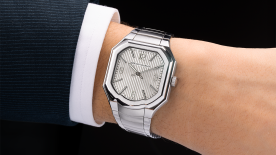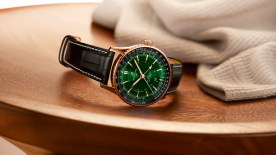Paris, 12 Pluviôse, year 6 of the French Republic (January 31st 1798). The Neuchâtel-born horologist Abraham-Louis Breguet applied for a patent to protect what he described as an “escapement that serves to deliver force in a constant and always equal manner in time-measuring machines”. He called a “Tourbillon”.
In other words, horologists had long since noted that the regularity of rate of a mechanical watch is influenced by the vertical position in which the latter is placed: gravity, the unique force directed towards the centre of the Earth, is responsible for this phenomenon. The principle of the Tourbillon is to fit the regulating organ of the watch (the balance, balance-spring and escapement) inside a carriage that spins on its axis, generally at a rate of one turn per minute. This constantly mixes up successive vertical positions, resulting in a very regular mean rate and thus extreme precision for a mechanical watch.
To overcome the negative effects of gravity.
To put it quite simply, the Tourbillon makes a watch impervious to the negative effects of gravity. But its simplicity goes even further. The Tourbillon is still considered to be a major horological invention, as well as the expression of a skill and dexterity that few watchmakers are capable of producing.
During the quarter century after Breguet’s death, the Tourbillon fell into oblivion. The swift progress of traditional watchmaking made it possible to achieve satisfactory precision results in more simple ways. It was nonetheless awakened from its slumber in the mid-19th century, doubtless for two reasons: the burgeoning enthusiasm for international exhibitions and their competitions; and, for Swiss watchmakers, the creation of an observatory in Neuchâtel. The point was to shine among one’s peers, and if possible to outshine them.

The general consensus is that the oldest Swiss Tourbillon model dates back to around 1850. It consisted of a key-wound movement with fusée and chain to which some more or less well-known watchmakers added on their own Tourbillons. Subsequently, a majority of producers began to use two more modern base movements. Although fairly similar in structure, they were mainly distinguished by different bridges. They featured pendant winding and have no fusée and chain.
Constant Girard-Perregaux was an excellent watchmaker who took a keen and early interest in the Tourbillon and used one of these movements himself, particularly in a watch that earned a gold medal at the Universal Exhibition held in Paris in 1867. As well as enriching it with a Tourbillon, he also equipped it with a detent-type escapement and deadbeat seconds (an independent hand moving in jerks), which required a second barrel to handle the winding.
As far as the “three Bridges” are concerned, a glance at the watches made by Constant Girard-Perregaux between 1860 and 1880 provides a foretaste of his master work: gold was used as a genuinely functional material, arrow-shaped bridges made their appearance, the overall structure was starting to taking shape… One can rightly speak of a lengthy and patient development process leading to the introduction of the three Bridges – initially placed parallel and not made of gold, and then subsequently in gold and shaped like arrows.

Le mouvement n'est plus qu'un composant technique, il participe à l’esthétique de la montre.
The work of Constant Girard-Perregaux was honoured in Paris with a gold medal at the 1889 Universal Exhibition. This deserves a closer look, since the Tourbillon with Three Gold Bridges is an impressive compendium of aesthetic and technical features – along with what some observers perceive as a certain symbolic value. It is a truly unique case in the watch industry.
As mentioned above, other manufacturers used standard base movements onto which they fitted their Tourbillons. The quality of the work done by each of those involved is not apparent at first glance, but must be sought in the details, such as the quality of the finish or the wealth of the decorative motifs. Conversely, Constant Girard-Perregaux tackled elements that had been neglected by his peers, such as the structure of the movement itself as well as the shape of its components.
The movement thus ceases to be a purely technical component, but contributes to the overall aesthetic of the watch, to the point where it becomes an instantly recognisable feature: there is no need to make out the brand name on the dial, since a single glance at the movement is enough to identity the maker.
The Tourbillon with Three Gold Bridges is an icon in Swiss watchmaking, and rightly so. For the contemporary Girard-Perregaux company, it is not merely part of its heritage, since production continues to this day. It is instead a challenge: that of ensuring respect for the spirit of the man who created the concept, while interpreting it in a modern way.

Willy Schweizer is Curator of the Girard-Perregaux Heritage







